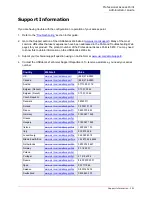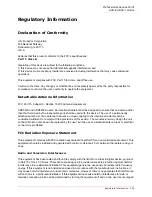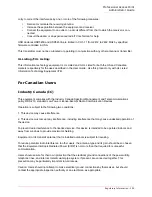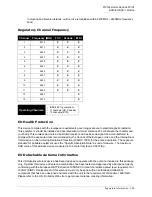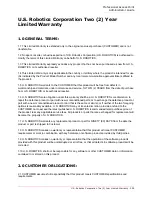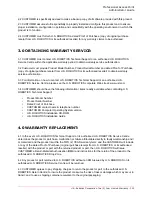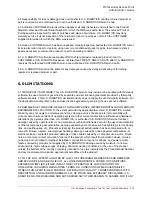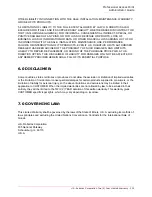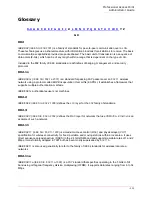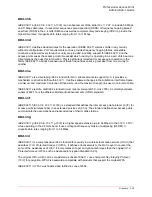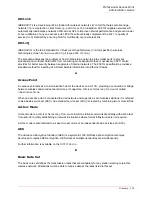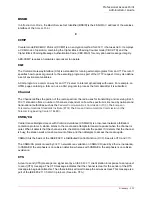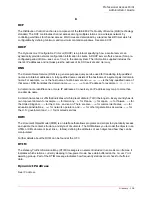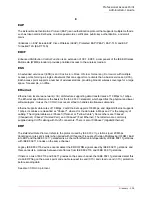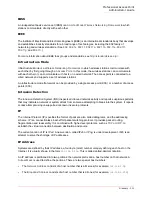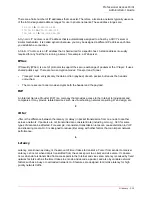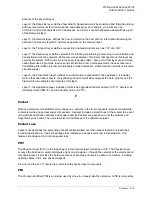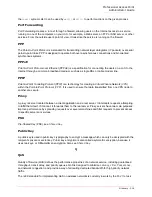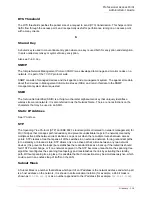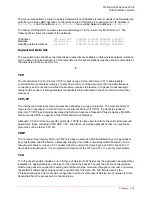
Professional Access Point
Administrator Guide
Glossary - 304
802.11b
IEEE 802.11b
(
IEEE Std. 802.11b-1999
) is an enhancement of the initial
802.11
PHY
to include 5.5 Mbps
and 11 Mbps data rates. It uses direct sequence spread spectrum (DSSS) or frequency hopping spread
spectrum (FHSS) in the 2.4 GHz ISM band as well as complementary code keying (CCK) to provide the
higher data rates. It supports data rates ranging from 1 to 11 Mbps.
802.11d
IEEE 802.11d
defines standard rules for the operation of IEEE 802.11 wireless LANs in any country
without reconfiguration. PHY requirements such as provides frequency hopping tables, acceptable
channels, and power levels for each country are provided. Enabling support for IEEE 802.11d on the
access point causes the access point to broadcast which country it is operating in as a part of its beacons.
Client stations then use this information. This is particularly important for access point operation in the
5GHz IEEE 802.11a bands because use of these frequencies varies a great deal from one country to
another.
802.11e
IEEE 802.11e
is a developing
IEEE
standard for
MAC
enhancements to support
QoS
. It provides a
mechanism to prioritize traffic within
802.11
. It defines allowed changes in the Arbitration Interframe Space,
a minimum and maximum Contention Window size, and the maximum length (in kµsec) of a burst of data.
IEEE
802.11e is still a draft
IEEE
standard (most recent version is D5.0, July 2003). A currently available
subset of 802.11e is the
Wireless Multimedia Enhancements
(
WMM
) standard.
802.11f
IEEE
802.11f (
IEEE Std. 802.11f-2003
) is a standard that defines the inter access point protocol (
IAPP
) for
access points (wireless hubs) in an extended service set (
ESS
). The standard defines how access points
communicate the associations and reassociations of their mobile stations.
802.11g
IEEE 802.11g
(
IEEE Std. 802.11g-2003
) is a higher speed extension (up to 54 Mbps) to the
802.11b
PHY
,
while operating in the 2.4 GHz band. It uses orthogonal frequency division multiplexing (OFDM). It
supports data rates ranging from 1 to 54 Mbps.
802.11i
IEEE 802.11i
is a comprehensive
IEEE
standard for security in a wireless local area network (
WLAN
) that
describes
Wi-Fi
Protected Access 2
(
WPA2
). It defines enhancements to the
MAC
Layer to counter the
some of the weaknesses of
WEP
. It incorporates stronger encryption techniques than the original
Wi-Fi
Protected Access
(
WPA
), such as Advanced Encryption Standard (
AES
).
The original
WPA
, which can be considered a subset of 802.11i, uses
Temporal Key Integrity Protocol
(
TKIP
) for encryption. WPA2 is backwards-compatible with products that support the original WPA
IEEE
802.11i /
WPA2
was finalized and ratified in June of 2004.
Summary of Contents for Instant802 APSDK
Page 1: ...Professional Access Point Administrator Guide R46 1224 00 rev 2 0 07 06...
Page 2: ......
Page 4: ...Professional Access Point Administrator Guide iv...
Page 8: ...Professional Access Point Administrator Guide viii...
Page 42: ...Professional Access Point Administrator Guide Basic Settings 42...
Page 52: ...Professional Access Point Administrator Guide Access Points 52...
Page 58: ...Professional Access Point Administrator Guide User Management 58...
Page 62: ...Professional Access Point Administrator Guide Sessions 62...
Page 70: ...Professional Access Point Administrator Guide Channel Management 70...
Page 88: ...Professional Access Point Administrator Guide Neighboring Access Points 88...
Page 96: ...Professional Access Point Administrator Guide Ethernet Wired Settings 96...
Page 120: ...Professional Access Point Administrator Guide Security 120...
Page 128: ...Professional Access Point Administrator Guide Virtual Wireless Networks 128...
Page 134: ...Professional Access Point Administrator Guide Radio 134...
Page 138: ...Professional Access Point Administrator Guide MAC Filtering 138...
Page 152: ...Professional Access Point Administrator Guide Quality of Service 152...
Page 160: ...Professional Access Point Administrator Guide Wireless Distribution System 160...
Page 164: ...Professional Access Point Administrator Guide Time Protocol 164...
Page 170: ...Professional Access Point Administrator Guide SNMP 170...
Page 290: ...Professional Access Point Administrator Guide Configuration Troubleshooting 290...
Page 298: ...Professional Access Point Administrator Guide Regulatory Information 298...
Page 328: ...Professional Access Point Administrator Guide Index 328...


